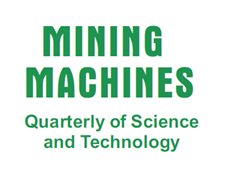Test rig, methodology and testing the hydraulic engines supplied with water-oil emulsion
BALAWENDER A., ŚLIWIŃSKI P.
Adaptive control of the electro-hydraulic drive in changeable load conditions
DINDORF R., WOŚ P., WOŁKOW J.
Studies on the sealing nods in transitory states of the machine mechanisms
GAWRYŚ E, KOLLEK W., KUDŹMA Z., PALCZAK E.
Influence of working fluid viscosity on the change of the operational parameters range of hydraulic engine and on energetic efficiency of the system with proportional control
PASZOTA Z.
Testing the hydraulic executing components in the powered roof support unit in the aspect of European Union requirements
MADEJCZYK W.
Active path of the beater extension in a percussive mechanisms of the hydraulic WOU-42SM rotary-and-percussive drill
KALUKIEWICZ A, NIEŚPIAŁOWSKI K., WARACHIM W.
Hydraulic cylinder – a machine or pressure installation in the light of European directives
GAWOL J., KACZMARCZYK J.
Scientific-and-technical information as the supporting component in the knowledge management
ZAJĄC R.
Test rig, methodology and testing the hydraulic engines supplied with water-oil emulsion
BALAWENDER A., ŚLIWIŃSKI P.
S u m m a r y
A new test rig designed and constructed at the Hydraulics and Pneumatics Department of the Gdańsk Technical University to study hydraulic engines supplied with water-oil emulsion was described. The testing methodology as well as test results of a new satellite hydraulic engine of the HS type designed, among others, to be used in the mining industry was given. A comparison of results obtained from the tests with an engine supplied with water-oil emulsion was performed.
Adaptive control of the electro-hydraulic drive in changeable load conditions
DINDORF R., WOŚ P., WOŁKOW J.
S u m m a r y
An idea of the adaptive controller used in the control system of the electro-hydraulic drive operating in changeable load conditions was presented. An analysis of the PID adaptive controller was performed by a determination of its parameters, basing on the parameters of the model. A simulation of the adaptive controller using an identification with the recurentive least squares (RLS) method with compensation system was given.
Studies on the sealing nods in transitory states of the machine mechanisms
GAWRYŚ E, KOLLEK W., KUDŹMA Z., PALCZAK E.
S u m m a r y
The results of studies on sealing nods in the hydraulic rams of the machine mechanisms were given. Some of the durability tests in the ram prototypes as well as their behaviour in the machine mechanisms transitory states were presented.
Influence of working fluid viscosity on the change of the operational parameters range of hydraulic engine and on energetic efficiency of the system with proportional control
PASZOTA Z.
S u m m a r y
The influence of working fluid (a hydraulic oil) viscosity, determined by a simulation, on “ki” and “a” factors, which characterize the hydraulic system components, was presented. The “ki” loss factors, which change their values with the change of oil viscosity , influence the energetic efficiency η for the specified speed facto and engine load factor . From the other side the “ki” factors influence the amount of the system’s operational area, determined by the range of factors and change, and in the result they influence a maximal value of the ηmax system efficiency, possible to be achieved. That was shown on an example of the system with a proportional control, where the throttling separator is supplied with a pump of the constant output, operating with the overflow valve.
Testing the hydraulic executing components in the powered roof support unit in the aspect of European Union requirements
MADEJCZYK W.
S u m m a r y
The requirements which the hydraulic executing components in the powered roof support unit should meet from the day of 1st of May, were presented. The Polish Standards PN-EN 1804-1:2202(U) and PN-EN 1804-2:2202(U) have a status of standards harmonized with the 98/37/EC Machine Directive being in force in European Union.
Active path of the beater extension in a percussive mechanisms of the hydraulic WOU-42SM rotary-and-percussive drill
KALUKIEWICZ A, NIEŚPIAŁOWSKI K., WARACHIM W.
S u m m a r y
Conditions of the hydraulic impact occurrence in a percussive mechanism of the hydraulic WOU-42SM rotary-and-percussive drill were presented. The amount of hydraulic impact in relation to the beater stroke was determined on the basis of the performed studies and its relationship with a total beater impact force was determined as well.
Hydraulic cylinder – a machine or pressure installation in the light of European directives
GAWOL J., KACZMARCZYK J.
S u m m a r y
The bill about a conformity assessment system obliges the producers to make a conformity assessment of products before their commercialization. The conformity assessment process requires to carry out the analyses of records included in the general and detail requirements. The procedure which should be followed in conformity assessment, interpretation difficulties of requirements as well as participation of notified bodies in that process were described.
Scientific-and-technical information as the supporting component in the knowledge management
ZAJĄC R.
S u m m a r y
Information is the knowledge indispensable for a realization of tasks needed to the institutions to reach specified objectives. Information means a documentation, data, news having a great significance, a their proper circulation is a condition of an effective management. Recently it was stated that information management is a vital part of organizational management. In the environment where technologies and methodologies become out-of-date, a men faces the necessity of possessing detailed, actual and complete data indispensable for taking rational decisions. The present paper focuses only on scientific-and-technical information, which is only a small part of knowledge and information management.
KOMAG Institute of Mining Technology
MISSION
Innovative solutions for economy.
VISION
Research and development centre of organizational and proprietary structure adapted to the market activity in the European Research Area and of the organizational culture creating a friendly climate for generating new ideas and realizing innovative activities, i.e. transforming new ideas into new products.
Read moreDesign
Designing of machines and equipment
Tests
Laboratory of Applied Tests
Certification
Assessment of products' conformity
Projects
Projects realized by the KOMAG Institute from European Funds
© 2025 KOMAG Institute of Mining Technology





 Badanie bezpieczeństwa wyrobów
Badanie bezpieczeństwa wyrobów Klaster Maszyn Górniczych
Klaster Maszyn Górniczych